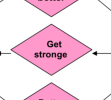Mij
Senior Member (Voting Rights)
Overview of the therapy
As the remit of the guide is active therapy the rationale for the rehabilitation approach is included. The World Health Organisation has defined rehabilitation as:
"A process aimed at enabling people to reach and maintain their optimal physical, sensory, intellectual, psychological and social functional levels. Rehabilitation provides people with the tools they need to attain independence and self-determination.”
The World Health Organisation considers that access to rehabilitation is a human right. The WHO “optimising” approach to rehabilitation can form part of the dialogue with the person with ME/CFS when forging a therapeutic alliance.
"Based on values and goals".
As the remit of the guide is active therapy the rationale for the rehabilitation approach is included. The World Health Organisation has defined rehabilitation as:
"A process aimed at enabling people to reach and maintain their optimal physical, sensory, intellectual, psychological and social functional levels. Rehabilitation provides people with the tools they need to attain independence and self-determination.”
The World Health Organisation considers that access to rehabilitation is a human right. The WHO “optimising” approach to rehabilitation can form part of the dialogue with the person with ME/CFS when forging a therapeutic alliance.
"Based on values and goals".



